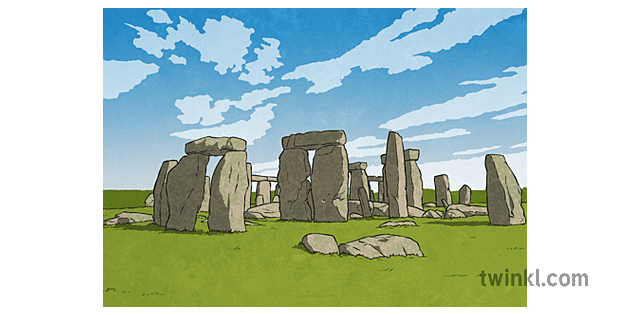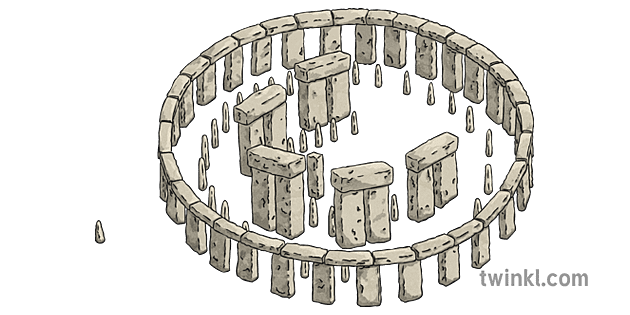



Stonehenge is a monument shrouded in mystery. As one of the most famous historical landmarks in the United Kingdom and a fantastic example of the prehistoric culture that once thrived in the British Isles, it attracts hundreds of thousands of visitors every year.
Keep on reading to find out about its history, potential uses and iconic features.
|
Name |
Stonehenge |
|
Building Type |
Prehistoric monument |
|
Location |
Salisbury Plain, Wiltshire |
|
Date Built |
Built in stages, starting over 5,000 years ago. |
|
Built By |
Neolithic people |
|
Height/Size |
The Stonehenge enclosure is around 100 metres in diameter. The blocks of stone that make up Stonehenge average between 5–6 metres tall and weigh around 25 tons. |
Stonehenge is found on Salisbury Plain in Wiltshire, which is a county in the south of England. As well as being home to Stonehenge, Salisbury Plain is owned and used by the Ministry of Defence.
Stonehenge was constructed in different phases starting around 5,000 years ago in approximately 2,500 BC. Earlier structures from before the construction of the stone circle have been found in the immediate area of Stonehenge, and these have been dated back even further, to between 8,500 and 7,000 BC.
There is no definite answer as to who built Stonehenge, though scientists and archaeologists over the centuries have all had their theories.
In the 12th century, it was suggested that Stonehenge had been created by the wizard Merlin. This theory was created by the writer Geoffrey of Monmouth, who wrote many tales about Merlin. Whilst we know this definitely isn’t the case now, people believed this theory well into the Middle Ages.
The next popular theory was formed by archaeologist John Aubrey in the 17th century. He thought that Stonehenge had been created by the Druids, who were Celtic high priests. Whilst many people still celebrate Druidism at Stonehenge, a study done in the mid-20th century showed that Stonehenge had been built over 1,000 years before the Celts arrived.
Today, the widely held belief is that Stonehenge was created by a series of tribes living in the area over different times. It starts with the Neolithic tribes, who were most likely from the British Isles. After that, scientists aren’t so sure. Some scientists believe that Stonehenge was built entirely by the following generations of those early tribes; others think that other tribes from different places took over.
Much like the mystery as to who built Stonehenge, there is no definitive answer as to why Stonehenge was built.
To start, historians and archaeologists have noted how the blocks of stone align with the movements of the sun. In fact, the design of Stonehenge seems to hinge on the solstices, where the sun is at its most extreme positions throughout the year. This means that Stonehenge might have been used by the tribes to figure out what point of the year they were at.
If this is the case, there is also a good chance that Stonehenge was used to celebrate the solstices. The summer and winter solstices were very important times of the year as they gave people the chance to celebrate, feast, worship and remember those who had passed.
There is also reason to believe that Stonehenge was built in relation to the movement of the moon. Remains of cremations buried between 3,000 and 2,800 BC in the southeastern area of the monument also share the same direction of the most southerly rising position of the moon.

Looking at Stonehenge, you can see that the monument is made up of lots of different stones. Many of these stones have been given their own names and purposes by historians and archaeologists over the years. There are also two different types of stone that have ended up as part of Stonehenge.
The two types of stone at Stonehenge are called bluestones and sarsen stones. Technically, there are more than two types of stone, but they’ve been organised into two groups. Sarsen stone is a type of hard sandstone that is commonly found in the south of England, where Stonehenge was built. The other type, bluestone, is a name given to the stones at Stonehenge that aren’t local to the area. These are igneous rocks like dolerites and rhyolites that are from Preseli Hills in southwest Wales.
The outer circle of stones in Stonehenge are called sarsens. These stones are arranged in threes, called trilithons, with two of the stones standing upright and the third on top. The stone that’s on top is called a lintel. If Stonehenge was completed, it’s thought that the lintels would’ve formed a circle 30 metres in diameter, suspended 4 metres high.
Some of the stones at Stonehenge have been given their own names over the centuries. These include:

|
Year |
Event |
|
8,000 – 7,500 BC |
Some structures have been found dating back to this time, the Mesolithic period. These include four or five pits, three of which might have held ‘totem-pole like’ posts. Whilst these have been found in the same area as Stonehenge, there’s no evidence directly linking them together. |
|
3,500 BC |
The Greater Cursus (sometimes known as the Stonehenge Cursus) and the Lesser Cursus date back to around this period. These Neolithic monuments are also known as rectangular earthworks, and they’re enclosures surrounded by banks and ditches. |
|
3,000 BC |
The earliest form of the Stonehenge monument dates back to around this time. This early version was made up of a circular ditch that enclosed an area with two entrances. Within this structure, there are 56 pits, known as the Aubrey Holes, which may have held timber posts or stones. In and around the Aubrey Holes, evidence of cremations and burials have been found. This suggests that the early Stonehenge was used as a burial site. |
|
2,500 BC |
Around this time, the stones start to be set up in the centre of the monument. These were organised into an outer circle and an inner horseshoe. It’s also thought that other stones around the site, like the Station Stones, were set up in this era. Between 200 and 300 years later, it looks like the central stones were rearranged to form a circle and an inner oval. |
|
1,800-1,500 BC |
This period marks the last of the prehistoric activity at Stonehenge. This activity was digging two concentric pits around the stones in the Sarsen Circle. These pits are called the Y and Z holes. |
|
700 BC |
Sometime around 700 BC, in the Iron Age, a hillfort was constructed near Stonehenge. This hillfort, which would come to be known as Vespasian’s Camp, is the only Iron Age hillfort in the Stonehenge area. |
|
43 AD |
Stonehenge was often visited by the Romans and Romano-British people. Lots of Roman objects have been found around the Stonehenge site, and recent work on the site suggests that Stonehenge was a place of great importance to the Romano-British people. |
|
14th century |
The first surviving written references to Stonehenge are from the medieval period, dating to sometime around the 14th century. It’s around this time that Sir Geoffrey of Monmouth writes that Stonehenge was created by the wizard Merlin. |
|
19th century |
The introduction of turnpike roads and the railway to Salisbury in the late 19th century allowed many more people to come and visit Stonehenge. In 1897, the Ministry of Defence bought up a lot of the land on Salisbury Plain as a space to carry out training exercises. Much of the land is still owned by the Ministry of Defence today. Parts of Stonehenge were starting to fall, with some of the stones being supported by timber poles. |
|
20th century |
In the year 1900, one of the larger Sarsens fell. At this point, major restoration projects were planned to get the fallen stone back in place and to restore the remaining stones to keep Stonehenge safe. This process of conserving the stones in Stonehenge carried through different projects until 1964. In 1918, Stonehenge was given to the people of the nation by its final private owner. Since then, it has been protected and conserved by English Heritage, with the National Trust buying land around the monument. The work of these organisations ensures that Stonehenge will be protected and visitors will be able to visit the monument for many years to come. |

Have you enjoyed reading about Stonehenge? If you’d like to teach your children about the amazing monument, have a look at the resources below.
This download contains an awesome illustrated PowerPoint that you can use with your children. At the end of the PowerPoint, there’s a quiz ready to go that you can use to see how much your children have learnt.
This pack of differentiated fact files will be great for your class, with fact files ready for three different ability levels. You could ask your children to make posters using the facts they’ve learnt from these sheets.
If you’re teaching your children about megaliths like Stonehenge, this is a super activity that your children will love. Using biscuits, your children can try to build their very own henge!